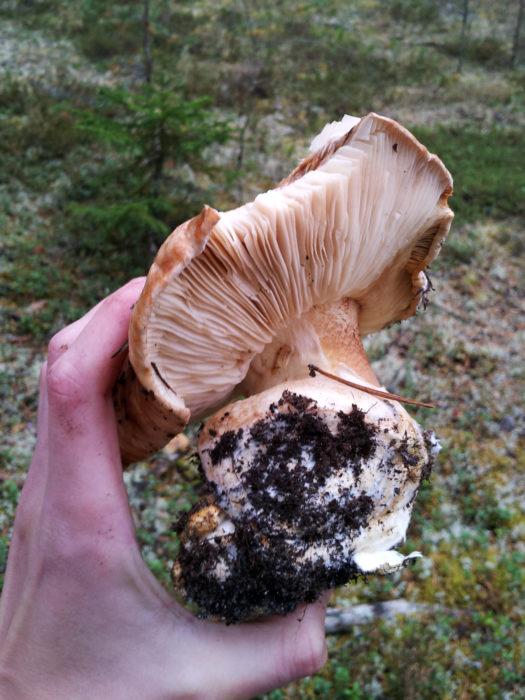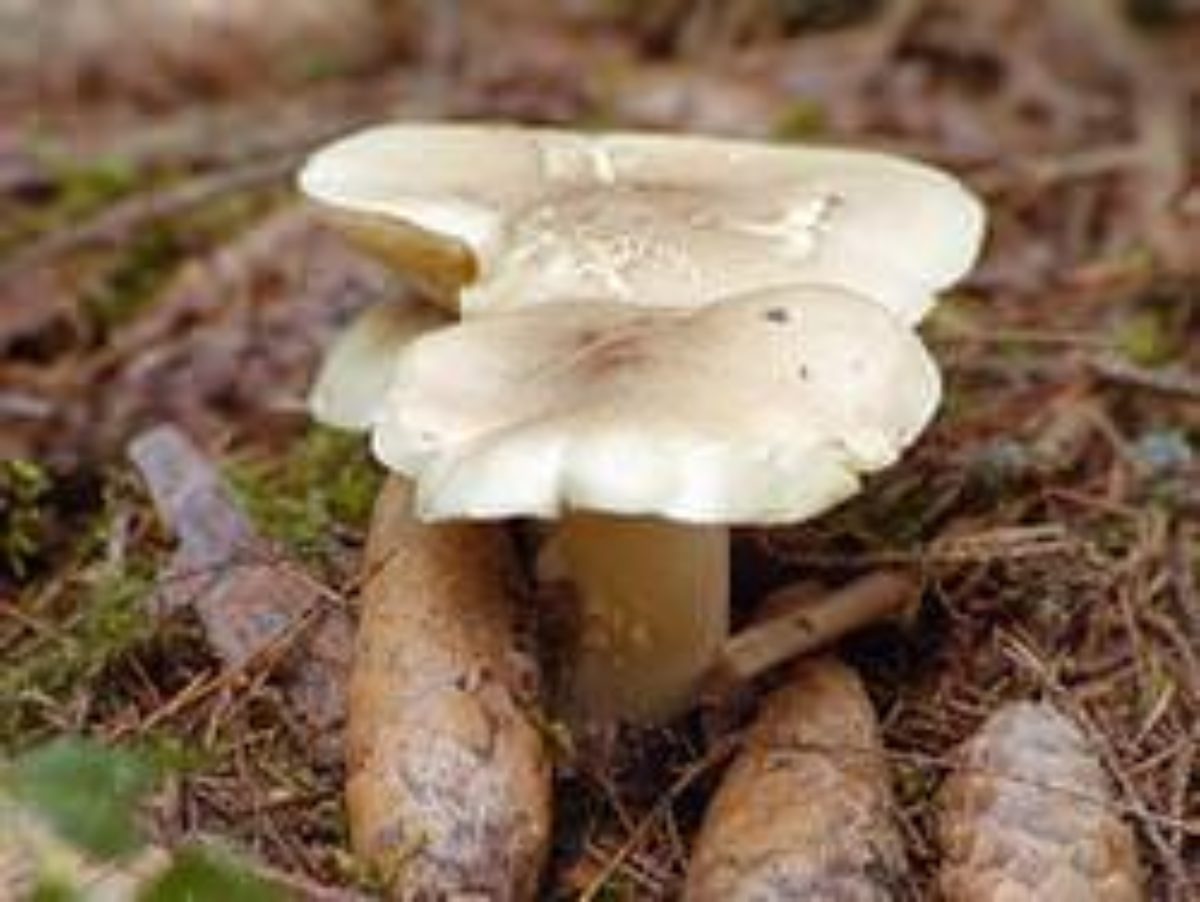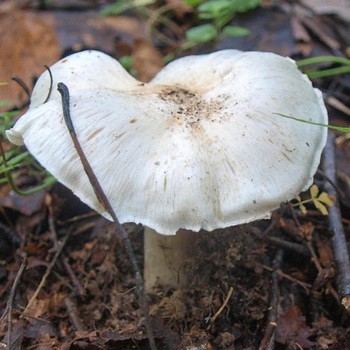False doubles Rows brown
Some related species of rowers are so similar to sweetmeat that only microscopic analysis allows you to see the differences. The table shows the characteristics of similar species.
| Double name | Hat | LPs | Pulp | Leg | Where is found | Food category |
| Row white-brown (Tricholoma albobrunneum) | With a diameter of 3-10 cm, in young mushrooms it is wine-brown with dark veins, in old ones it is red-brown. The skin is cracked to small scales, shiny. In wet weather - mucous. | Frequent, adherent to the stem, white, pinkish-brown, in mature mushrooms - with reddish-brown spots. | White, dense, under the skin - with reddish veins. The smell of flour or is absent. Mealy, bitter taste | Length 3-10 cm, thickness up to 2 cm, cylindrical or slightly thinned downwards. | In coniferous and mixed forests on poor soils. Forms mycorrhiza with pine. | Conditionally edible mushroom |
| Row yellow-brown (Tricholoma fulvum) | 3-15 cm in diameter, yellow-brown, smooth, without scales. In rainy weather, brilliant | Notched-adherent, wide, frequent or sparse. Cream to light yellow, brown with age with dark spots | Dense, with a bitter odor | 12-15 cm long, 0.5-2 cm thick, cylindrical or widened towards the base, fibrous, rigid. White at the top, cap colors at the bottom | In deciduous and mixed forests. Forms mycorrhiza with birch | |
| Tied row (Tricholoma focale) | Diameter 5-10 cm, bright, with copper shades. The surface is fibrous-scaly, the edges are omitted | Frequent, teeth adhered to the peduncle, white or yellowish | White, dense, firm, reddish under the skin. There is no smell or weak flour. Tasteless or bitter | 4-10 cm long, up to 3 cm thick, straight or fusiform, sometimes thinning downwards. In young mushrooms, dense, hard, in old ones, hollow, longitudinally fibrous | In pine forests on sandy soils | |
| Cow's row (Tricholoma vaccinum) | 3-8 cm in diameter, red-brown, with tousled fringes around the edges, large scaly | Rare, white or yellowish | White or yellowish, bitter | Length 5-9 cm, thickness 1-1.5 cm, straight, white top, bottom - cap colors | In spruce forests, sometimes in pine forests, rarely in mixed |
To better understand the difference between mushrooms, take a look at the photo. There is no information about dangerous false doubles
There is no information about dangerous false doubles.
Description and photos of purple row mushrooms:
 Row purple (Lepista nuda)
Row purple (Lepista nuda)
Synonyms: naked lepist, titmouse, cyanosis.
It is noteworthy that about a month before the beginning of fruiting, the purple ryadovka mycelium emerges on the surface of the forest litter. So to speak, it carries out reconnaissance in force. At first, the mycelium is almost white, pale bluish, but rather quickly turns into a light purple color characteristic of the fungus itself. Having found such a purple "cotton wool" enveloped in rotten needles and leaves, you can confidently take a note of the cherished place and come here in season for a guaranteed harvest.
The blues owe their pleasant fruity sweetish taste to the sugar trehalose, which is also found in meadow mushrooms. Cultivated in a number of countries.
Description of the purple row:
One of the most popular and most delicious late autumn rows. The cap is 4-20 cm in diameter, flat-convex, with a thin curved edge, naked, smooth, watery, moist, thick-fleshed. The color of the cap is necessarily with a significant proportion of violet: bright, dark or purple-violet, sometimes with an admixture of brown, in the center - brown-violet. Plates are frequent, purple, later light purple to pale lilac.
The pulp is thick, dense, bright purple, with age it fades like a cap or even stronger, the taste and smell are pleasant.Stem 3-10 x 0.7-3 cm, dense, cylindrical, slightly thickened below, covered with purple-brown felt mycelium at the base, purple at an early age, later lightening, whitish-mealy under the cap, sometimes hollow with age.
It is found throughout the temperate forest zone of Russia, in forests on soil and forest litter. Autumn mushroom, bears fruit in large groups from early September to late November (with peaks after the first cold in September and early October), often everywhere.
Healing properties of purple ryadovka:
The mushroom is high in vitamin B, stearic acid and ergosterol.
The extract of the cultural mycelium of this talker has anticancer properties and inhibits the growth of sarcoma-180 by 90% in laboratory animals, and Ehrlich's carcinoma by 100%. It has a strong cytotoxic effect on human cells of the L-1210 tumor line; in culture, it can inhibit the development of MCF-7 breast cancer and Walker 256 sarcoma.
The antibacterial action targets both gram-positive and gram-negative bacteria. The growth of E. coli, Staphylococcus aureus, Streptococcus pyogenes and Streptococcus enteretidis is inhibited. Antifungal activity was also found (suppresses Candida albicans).
Contains vitamin B, effective against beriberi disease, lowers blood glucose levels. Currently, on the basis of purple ryadovka, a dietary drug is being developed to control hypoglycemia.
In addition, ryadovka violet has anti-inflammatory and immunomodulatory activity, promotes platelet aggregation and increases the body's resistance to the influenza virus.
In Chinese medicine, regular consumption of food is believed to help maintain the nervous system. It is also used to regulate sugar metabolism, treat spleen, rheumatism and dermatophytosis of the legs.
It is not assembled for medicinal purposes in Russia.
Cooking Uses:
Edible and tasty mushroom, does not require (from our point of view) preliminary boiling. It is used for preparing first and second courses, snacks, salads, fillings.
Information about the allergenicity or toxicity of the violet row, which appeared at different times from different authors, has now been refuted by a number of studies. However, you should be aware that bruises are one of the most active bioaccumulators of anthropogenic pollution (ranked third after May mushroom and pigs), primarily heavy metals (tin, copper, mercury, cadmium). Therefore, you should avoid collecting them in city parks and in forests near industrial sites.
Row gigantic, or gigantic (Tricholoma colossus)
Edible mushrooms
The row is gigantic, or gigantic (Tricholoma colossus) is an edible mushroom from the Tricholomov family, belonging to the Ryadovok genus. Other names: giant ryadovka, colossus ryadovka, huge ryadovka immediately speak of the excellent size of the mushroom. Its diameter can reach from 10 cm to 22 cm, the shape is semicircular, and the edges are always tucked up. Ryadovka gigantic belongs to rare varieties of mushrooms and practically does not occur in the Saratov region. A gigantic row forms mycorrhiza with pine, begins to bear fruit in August and yields a harvest until the end of September... The mushroom prefers to live mainly in pine forests, but gigantic ryadovka can be found in mixed forests.
It is a fairly popular and edible species that amateurs hunt for. It goes well in soup and is also used as an appetizer. It is best to salt, pickle or cook such a mushroom. Before pickling, I soak it for half an hour so that the bitterness goes away, then boil it for the same half hour. Some people use a frying leg, though. It goes well with rice or buckwheat dishes. It is also often dried or frozen. Sometimes the row is collected not for food, but for medicinal purposes. It was found that the antibiotic clitocin is present in the composition of its pulp.It is valuable in that it is able to destroy the growth of pathogenic bacteria that lead to the development of oncological pathologies.
The fruit body of the described fungus is rather large in size. Initially, the shape of the cap of the giant row is semicircular, has turned up edges, but gradually it becomes flat-convex and even outstretched. The edges of the cap in mature mushrooms become raised, wavy.
The diameter of the gigantic ryadovka cap varies from 8 to 20 cm, and thin fibers are visible on its surface. The skin of the ryadovka cap is dry and completely smooth in wet weather, slimy. The color is reddish brown, sometimes reddish and even completely brown. The middle of the cap has a darker color range than its edges. As the fungus grows, the color of the cap can undergo significant changes.
The leg of the giant ryadovka is very large, massive, dense, characterized by a cylindrical shape. The base of the stem is slightly thickened and becomes tuberous in adulthood. Its length varies within 5-10 cm, and its thickness can be 2-6 cm. The shape of the leg can be straight, cylindrical, clavate or expanding to the top or bottom. The upper part of the leg, right under the cap, is often whitish, and in the center its color can be red-brown or yellowish.
Under the cap, ryadovka mushrooms have plates that are covered with a spore-bearing layer - hymenium. The plates are often located, wide, at a young age, the mushrooms have cream-colored or pale pink plates. The plates of mature mushrooms darken and become reddish-brown; with age, their surface turns brown, becomes covered with brown spots, and the edges become uneven or torn.
The mushroom pulp is characterized by its white color, compactness and high density. On the cut, the main color of the pulp can change to yellowish or reddish. The smell of the pulp is pleasant, and the taste is bitter, similar to the taste of an unripe walnut. In older specimens, it darkens and becomes reddish, the smell is herbaceous.
The giant row (Tricholoma colossus) is an edible mushroom, however, due to the rarity of the species, it is not recommended to collect such rows. In addition, in some regions of Russia and Europe, this mushroom is considered rare, and is listed in the Red Book.
Benefits and harm to the body
The benefits of giant rows in folk and official medicine are known. Valuable properties are manifested due to the content of enzymes, vitamins, minerals, amino acids in the composition of the plant product.
The obtained extracts from the giant rows help to cope with liver diseases, the organ cells are regenerated, and toxins are removed from the body. Dermatological ailments are treated with lotions from fruit bodies.
The enzymes contained in the plant product have a positive effect on the digestive tract, saturate the brain with useful elements, and protect the body from overwork.
A giant row can be harmful. Not recommended for children under 12 years of age, people with individual intolerance, nursing mothers. Fungi can provoke attacks of pain in patients with pancreatitis. Low acidity and dysfunction of the gallbladder are contraindications for the use of giant rows.
False doubles
In appearance, the spotted row may look like honey mushrooms, but it has a wider cap and a chunky leg. In appearance, matsutake has a lot in common with a corrugated row, or tied (Tricholoma focale), belonging to the conditionally edible mushrooms of the fourth category. Its cap is also fibrous-scaly, brown in color, there is also a ring on the leg, the flesh is light, fleshy. But unlike the shod ryadovka, it has a short leg that can be easily removed from the ground, and its smell is mealy. The pine mushroom is also very similar to the Sakhalin mushrooms.
All the external features of these types can be seen in the photo.
Comparative table of signs of similar mushrooms
| Name | Hat | Hymenophore | Pulp | Leg |
| Matsutake | Brown with large scales; diameter - 6–20 cm. | Lamellar, light color. | Dense white with the smell of fruit, pine, cinnamon. | Long, up to 20 cm; 1.5–2.5 cm in diameter. The fringed ring is unevenly located. |
| Real honey mushroom | From honey brown to olive; with a diameter of 3 - 10 cm. With sparse scales. | Lamellar, whitish-flesh-colored. | Whitish, pleasant smell. | 8-10 cm long, 1-2 cm in diameter. Covered with scales. Ring at the top. |
| Open-shaped row | 5-10 cm in diameter, tan or orange-red, with drooping edges. | Plates are frequent, notched, yellowish. | White, firm, with the smell of fresh flour, bitter. | Relatively short, from 4 to 10 cm long, up to 3 cm in diameter. Ring-skirt at the top. The lower part is painted to match the cap. |
| Sakhalin champignon | Diameter - 8-30 cm. Whitish, with age - gray. Almost flat, the edge is bent. | Whitish, dense, adherent or slightly descending. | Dense, tough, milky in color. | Length - 15 cm, diameter - 5 cm, white. It is thickened in the middle, narrowed at the base. Deeply rooted, has a double ring. |
Cooking recipes
They eat both a hat and a huge ryadovka leg. Popular recipes include:
- marinated with carrots in Korean;
- mycelium soup;
- stewed in sour cream sauce;
- ryadovka salted with garlic and pepper.
Primary processing
First, the mushroom is thoroughly washed, its leg is cleaned, as well as the cap with a knife. Then they rinse under running water, separate the elements from each other and soak for several hours. After that, you need to lay out the parts on a cutting board and let them dry. You can fold the mushrooms and freeze for the winter, or immediately proceed with further processing - frying, boiling, pickling.
How to cook a mushroom
The hats and legs are prepared in this way separately. The latter are undesirable to boil, although some experiment with taste. The hats are cleaned, soaked, and then, chopped up, they are boiled in salted water for about 60–90 minutes. They go perfectly into mycelium soup. Consider the recipe.
Calculation for 1 portion:
- rows (hats) - 500 g;
- onion - 1 pc .;
- salt - 2 tablespoons;
- sunflower oil - 2 tablespoons;
- carrots - 1 pc.;
- tomatoes –3 pcs .;
- potatoes - 3 pcs.
How to prepare:
- Separate the hat from the leg, cut into semicircles, soak in a container for an hour and a half.
- Finely chop onions and carrots, sauté in a skillet in tomato paste for 30 minutes.
- Mash tomatoes, add, fry over low heat.
- Put potatoes in boiling water, boil, salt.
- Pour mushrooms there, keep on fire for 60 minutes.
- Then drain the excess tomato moisture from the sautéing, add vegetables to the soup.
- Season with salt, pepper and a little soy sauce.
- You can use bay leaves for flavor and black peppercorns.
Pickling
First, let's prepare the marinade.
You will need:
- sugar - 100 g;
- salt - 100 g;
- garlic - 2 pcs.;
- bay leaf and carnation - 3 pcs.
How to cook:
- Add sugar, salt, finely chopped garlic (you can cut each slice into halves), pepper and laurel into a saucepan with cold water.
- Put on high heat, wait for a boil, then reduce the flame, cook for 10–20 minutes, add a tablespoon of vegetable oil and vinegar.
- Finish the process after 10 minutes.
The next option for harvesting mushrooms is the most common. You will need:
- rows - up to 1 kg;
- garlic - 1 pc.;
- salt - 2 tablespoons;
- table vinegar - 1 tablespoon;
- sugar - 1 tablespoon;
- bay leaf - 2-3 pcs.;
- pepper, cloves - 5 pieces each.
- Mushrooms are pre-cleaned, cut and placed in a saucepan with cold water. Cook them for about 40 minutes.
- The water is removed, the marinade is poured into the pan. In the solution, the fruits should be boiled for 10–20 minutes.
- Put the marinade in the refrigerator. After a day, stir with a wooden spoon. Put in a cool place.
Mushroom umbrella description
The edible umbrella mushrooms live up to their name. In the process of growth, forest gifts open their hats, previously adjacent to the legs, like an umbrella.However, many mushroom pickers do not know special signs confirming the edibility of the mushroom and distinguishing it from the toadstool counterparts and undeservedly bypass the delicious mushrooms.
- Edible umbrellas smell nice where the cap is broken, resembling a nut. The cut point does not change color upon contact with air.
- The leg of the non-poisonous mushroom has a three-layer ring framing it in the form of a skirt. Such an accessory can be easily moved up and down, while in inedible representatives it is firmly attached or completely absent.
- An important criterion by which you can immediately recognize a good umbrella mushroom is size. Edible individuals, when opened, reach 30 cm in height with a cap diameter of 40 cm, while externally identical toadstools have legs no more than 13 cm high and caps no wider than 14 cm in diameter.
- In the process of growing, the caps of umbrella mushrooms are covered with scales, which are often concentrated at the edges. Above, the cap is darker in color and smoother.
- The most common types of umbrella mushrooms are white, variegated and reddening.
Umbrellas can grow very large after heavy rains. The head of such a mushroom reaches a diameter of 35 to 45 cm, and the height of the leg grows to 30-40 cm.
On average, the mushroom has a stem length of about 8-10 cm and a diameter of the cap within 10-15 cm. The surface of the cap is dry and finely scaly; at the edges, the skin may crack and hang in the form of a fringe. The pulp and juice are of a light shade with a pleasant mushroom smell and delicate taste. The leg is thickened at the base, it has a characteristic mobile membranous ring.
Tips & Tricks
- If the mushrooms are boiled for further frying, the water must be salted. In this case, it is also recommended to rinse the product after boiling and let the water drain.
- A prerequisite for boiling porcini mushrooms is regular foam removal. To make the dried chanterelles cook well, you need to add a pinch of baking soda to the water. Peeled boletus legs will not darken if boiled without cutting.
- To preserve the taste and aroma of the mushrooms, it is recommended to cook them only over medium heat. To make the aroma when cooking boletus and mushrooms more pleasant, you need to add a couple of bay leaves to boiling water.
In order for dishes and preparations from umbrellas to be truly amazing, the following recommendations must be observed:
- Freshly picked mushrooms are considered the most delicious. Therefore, they should be prepared or processed immediately after collection or purchase.
- For connoisseurs of mushroom dishes, umbrellas that have not yet been opened are considered the most delicious. They are especially delicious when fried.
- These mushrooms must not be soaked in water. Having absorbed moisture, they will become unsuitable for frying.
Posted in Second courses, Lenten recipes | Tags: Mushrooms |
Posted in Second courses, Lenten recipes | Tags: Mushrooms | no comments
Umbrellas are tasty, widespread mushrooms. When cooked correctly, they make very satisfying and mouth-watering dishes. Foodies even grill them alongside vegetables and meats. They can also be used for winter storage, drying and freezing.
Description
Poisonous ryadovka is a rather dangerous species from the point of view of the possibility of poisoning. This mushroom has a pleasant taste atypical for poisonous specimens, so it is highly likely that it will not be recognized if it is accidentally consumed.
 Hat
Hat
The poisonous ryadovka hat is usually small - it grows only up to 12 cm in diameter. The shape of the cap of this mushroom in youth is semicircular, then gradually acquires the shape of a bell, in a mature state it becomes flat with edges facing downward.
The color of the cap varies from grayish white to asphalt gray. May have a bluish tinge. On the surface, dark concentrically located scaly growths are distinguished.

Leg
The leg of the poisonous ryadovka is rather long (up to 15 cm) and dense (up to 3.5 cm in diameter). The shape is cylindrical with a downward extension. Inside, the leg is solid, has no cavity.
Young mushrooms have light fiber on the surface of the legs, old specimens have an absolutely smooth stem.The color of the leg is white, from the second third it is orangeish, downwards it is rusty.
Spore-bearing layer
 The spore layer of the ryadovka poisonous lamellar. The plates reach a length of up to 1.2 cm, thick, sparsely spaced and dentate-adherent. Their color is yellowish or greenish-white. On the surface of the plates of mature specimens, the release of watery "dew" is observed.
The spore layer of the ryadovka poisonous lamellar. The plates reach a length of up to 1.2 cm, thick, sparsely spaced and dentate-adherent. Their color is yellowish or greenish-white. On the surface of the plates of mature specimens, the release of watery "dew" is observed.
Pulp
Hard, grayish (at the base of the mushroom - pale yellow), when cut, its color does not change. The taste is quite pleasant, not bitter, and the smell is typically "ordinary", mealy.
Spore powder
The spores are of medium size and ellipsoidal. Their surface is smooth. Separately, the spores are not colored; the bulk of the powder is white.
Definitioner
- Basidia (Basidia)
-
Lat. Basidia. A specialized structure of sexual reproduction in fungi, inherent only in Basidiomycetes. Basidia are terminal (end) elements of hyphae of various shapes and sizes, on which spores develop exogenously (outside).
Basidia are diverse in structure and method of attachment to hyphae.
According to the position relative to the axis of the hypha, to which they are attached, three types of basidia are distinguished:
Apical basidia are formed from the terminal cell of the hypha and are located parallel to its axis.
Pleurobasidia are formed from lateral processes and are located perpendicular to the axis of the hypha, which continues to grow and can form new processes with basidia.
Subasidia are formed from a lateral process, turned perpendicular to the axis of the hypha, which, after the formation of one basidium, stops its growth.
Based on morphology:
Holobasidia - unicellular basidia, not divided by septa (see Fig. A, D.).
Phragmobasidia are divided by transverse or vertical septa, usually into four cells (see Fig. B, C).
By type of development:
Heterobasidia consists of two parts - hypobasidia and epibasidia developing from it, with or without partitions (see Fig. C, B) (see Fig. D).
Homobasidia is not divided into hypo- and epibasidia and in all cases is considered holobasidia (Fig. A).
Basidia is the place of karyogamy, meiosis and the formation of basidiospores. Homobasidia, as a rule, is not functionally divided, and meiosis follows karyogamy in it. However, basidia can be divided into probasidia - the site of karyogamy and metabasidia - the site of meiosis. Probasidium is often a dormant spore, for example in rust fungi. In such cases, probazidia grows with metabasidia, in which meiosis occurs and on which basidiospores are formed (see Fig. E).

See Karyogamy, Meiosis, Gifa.
- Pileipellis
-
Lat. Pileipellis, skin - differentiated surface layer of the cap of agaricoid basidiomycetes. The structure of the skin in most cases differs from the inner flesh of the cap and may have a different structure. The structural features of pileipellis are often used as diagnostic features in descriptions of fungi species.
According to their structure, they are divided into four main types: cutis, trichoderma, hymeniderma and epithelium.
See Agaricoid fungi, Basidiomycete, Cutis, Trichoderma, Gimeniderm, Epithelium.
- Trichoderma (Trichoderma)
-
The type of cap skin, usually consists of straight, septate elements located more or less perpendicular to the surface and laid both at the same and at different levels; the ends of the hyphae can be morphologically modified and represent dermatocystids. The surface of the cap is velvety to almost felt.
Lat. Trichoderm.
Trichoderma, in turn, is subdivided into intertwined trichoderma and irregular trichoderma.
Intertwined trichoderm (Intricate trichoderm) - trichoderm, consisting of intertwined hyphae, located not parallel to each other and forming a tomentose pubescence.
Irregular trichoderm - Trichoderma, consisting of irregularly branching hyphae.
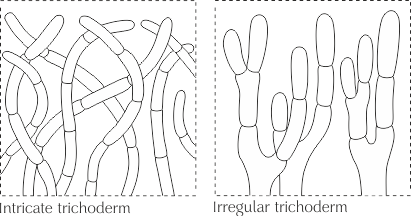
See Dermatotsistida, Hypha, Septa.
- Cutis
-
The type of cap skin, consists of creeping non-gelatinized hyphae located parallel to the surface. The surface of the cap looks smooth.
Lat. Cutis.
See Gifa.
Row stinky (Tricholoma Inamoenum)
Synonyms:
- Agaricus inamoenus
- Gyrophila inamoenum
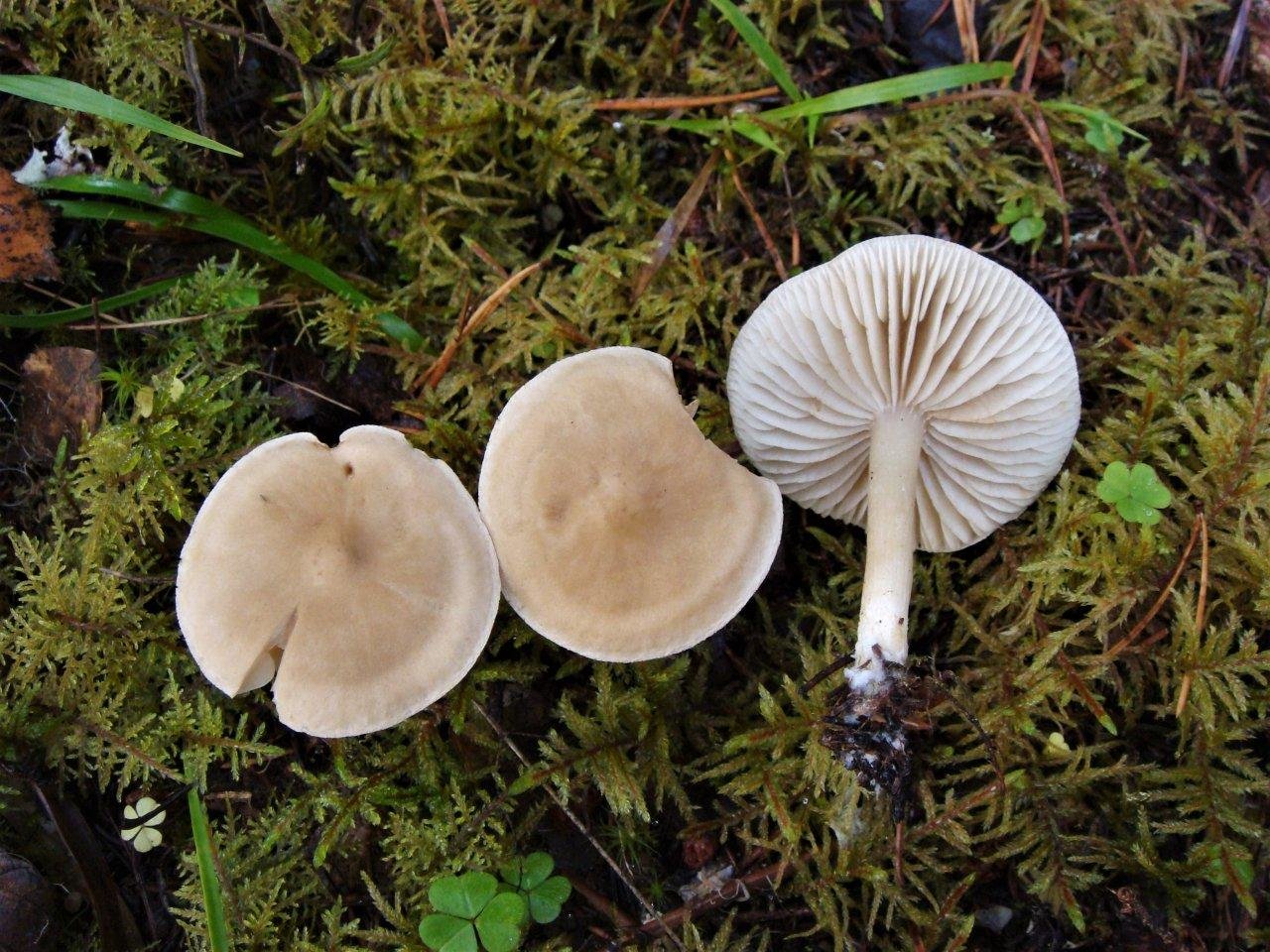
Description
A hat with a diameter of 1.5 - 6 cm (sometimes up to 8 cm); at first it has a shape from bell-shaped to hemispherical, but with age it straightens and becomes broadly convex, flat or even slightly concave. There may be a small bump in the center, but this is not necessary. The surface of the cap is smooth, dry, matte, slightly velvety; dull, at first whitish or creamy, later it darkens and becomes from honey or pinkish-dark beige to pale ocher, the color of natural suede, while the shade in the center of the cap is more saturated than at the edges.
The plates are adherent or notched, often with a descending tooth, rather thick, soft, rather wide, rather sparse, whitish or pale yellowish.
White spore powder, elliptical spores, 8-11 x 6-7.5 microns
The leg is 5 - 12 cm long and 3 - 13 mm thick (sometimes up to 18 mm), cylindrical or widened at the base; with a smooth, fine-fibrous or “powdered” surface; white to cream or pale yellowish.
The pulp is thin, white, with a strong unpleasant smell of tar or lamp gas (similar to the smell of a row of sulfur-yellow). The taste is mild at first, but then unpleasant, from slightly rancid to strongly bitter.
Ecology and distribution
The stinking row forms mycorrhiza with spruce (genus Picea) and fir (genus Abies). Usually it is confined to humid forests with a developed thick moss cover on the soil, but it can also be found in blueberry conifers. She prefers soils from slightly acidic to calcareous. It is a fairly common species in Scandinavia and Finland, as well as in the spruce and fir forests of Central Europe and the Alps. On the plains of northwestern Europe, both in places of natural growth of spruce and in artificial plantations, it is extremely rare or absent altogether. In addition, smelly ryadovka has been noted in North America, possibly making it a species throughout the northern temperate zone.
Similar species
Tricholoma lascivum has an odor at first unpleasantly sweet, later chemical, similar to the smell of lamp gas, and a very bitter taste. This species is strictly associated with beech. The white line Tricholoma album forms mycorrhiza with oak. The white line Tricholoma stiparophyllum forms mycorrhiza with birch and is found both in deciduous forests and in mixed (including spruce forests mixed with birch), it has a stinging taste , rare odor and frequent plates.
Edibility
The mushroom is inedible due to its disgusting odor and bitter taste.
The smelly ryadovka in some sources belongs to the category of hallucinogenic mushrooms; when eaten, it can cause visual and auditory hallucinations.
Similar species
Poisonous rowing has some similarities with certain types of rows:
Like a poisonous ryadovka, it forms mycorrhiza more often with conifers. Only this mushroom is even more modest in size, its plates are white, and the smell and taste are devoid of mealy.
The scales of this fungus on the surface of the cap are not gray, but greenish-brown, and the plates of the hymenophore are pinkish.
 1-Row earthy 2-Reddish row
1-Row earthy 2-Reddish row
It differs in that it does not have scaly outgrowths on the cap at all.
In this fungus, both the cap and the scales are covered with specific blackish growths.
It is extremely similar to the poisonous ryadovka, but differs in the presence of ring-shaped remains of the bedspread on the stem.
1-Gray row 2-Black-scale row 3-Belochampignon long-root
These types of rows are edible, so you should be careful when collecting them so that a poisonous row does not accidentally come across them.
Row silver
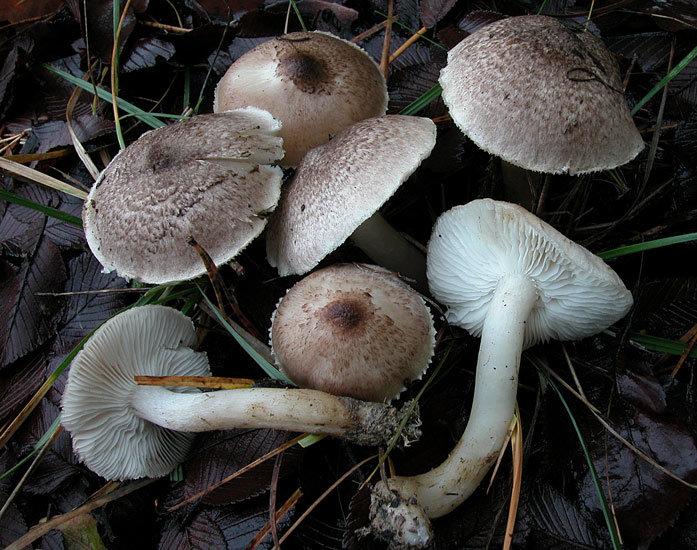
Silver row (Tricholoma scalpturatum)
- The row is yellowing;
- The row is carved.
Row silver (Tricholoma scalpturatum) is a mushroom belonging to the Tricholomov family, the Agarikov class.
External description
The fruiting body of the silvery row consists of a cap and a leg. The diameter of the cap varies within 3-8 cm, in young mushrooms it has a convex shape, and in mature mushrooms it is prostrate, with a tubercle in the central part. Sometimes it can be concave. In ripe mushrooms, the edges of the cap are wavy, bent, and often torn.The fruit body is covered with a skin with the finest fibers or small scales pressed to the surface. this skin is more often gray in color, but it can be gray-brownish-yellow or silvery-brownish. In overripe fruit bodies, the surface is often covered with specks of lemon-yellow color.
The fungal hymenophore is lamellar, its constituent particles are plates, they grow together with a tooth, often located in relation to each other. In young fruit bodies, the plates are white, and in ripe ones, they turn yellow in the direction from the edges to the central part. Often, on the plates of overripe fruit bodies of a silvery row, you can see yellowish spots, unevenly distributed over the surface.
The height of the stalk at the silvery row varies within 4-6 cm, and the diameter of the mushroom stalk is 0.5-0.7 cm.It is silky to the touch, thin fibers are visible to the naked eye. The shape of the stem of the described mushroom is cylindrical, and sometimes small pieces of skin are visible on its surface, which are the remains of a common blanket. In color, this part of the fruiting body is gray or whitish.
The structure of the mushroom is very thin, fragile, with a powdery color and aroma.
Season and habitat of the mushroom
Row silver grows in forests of various types. Often, this type of mushroom can be found in the middle of parks, squares, gardens, forest shelter belts, along roadsides, in grassy areas. You can see the described mushroom as part of large groups, since the scaly row often forms the so-called witch's circles (when whole colonies of mushrooms are connected to each other in large bundles). The fungus prefers to grow on calcareous soils. On the territory of Russia and, in particular, the Moscow region, the fruiting of silvery rows begins in June and continues until the second half of autumn. In the southern regions of the country, this mushroom begins to bear fruit in May, and the duration (during warm winters) is about six months (until December).
Edibility
The taste of the silvery ryadovka is mediocre; this mushroom is recommended to be eaten salted, pickled or fresh. It is advisable to boil the silvery ryadovka before eating, and drain the broth. It is interesting that when this type of mushroom is pickled, their fruit bodies change their color, becoming green-yellow.
Similar types and differences from them
Often, another type of mushroom, Tricholoma imbricatum, is called a silvery (scaly) row. However, both of these ryadovki belong to completely different categories of mushrooms. The silvery ryadovka described by us is similar in its external features to earthy ryadovka, as well as to above-soil tricholom mushrooms. Very often these types of mushrooms grow in the same place, at the same time. It also looks like a poisonous tiger row.
Mushroom photo Row silver from questions in recognition:
Gray row (Tricholoma portentosum)
- Other names for the mushroom:
- Podsosnovik
- Serushka
- Podgreen
- Sandpiper gray
Synonyms:
- The row is strange
- Podsosnovik
- Podgreen
- Sandpiper gray
- Serushka
- Agaricus portentosus
- Gyrophila portentosa
- Gyrophila sejuncta var. portentosa
- Melanoleuca portentosa
Description
Cap: 4-12, up to 15 centimeters in diameter, broadly bell-shaped, convex-spread with age, then flat-spread; in adult specimens, the edge of the cap may be slightly wavy and fissured. A wide tubercle remains in the center. Light gray, darker with age, with a yellowish or greenish tint. The skin of the cap is smooth, dry, pleasant to the touch, in wet weather it is sticky, covered with pressed fibers of a darker, blackish color radiating radially from the center of the cap, therefore the center of the cap is always darker than the edges.
Leg: 5-8 (and up to 10) centimeters long and up to 2.5 cm thick. Cylindrical, sometimes slightly thickened at the base, can be curved and go deep into the soil. White, grayish, grayish-yellowish, light lemon-yellowish, slightly fibrous in the upper part or may be covered with very small dark scales.
Plates: adherent with a tooth, medium frequency, wide, thick, thinning towards the edge.White in young mushrooms, with age - grayish, with yellowish spots or completely yellowish, lemon-yellow.
Bedspread, ring, volva: none.
Spore powder: white Spores: 5-6 x 3.5-5 microns, colorless, smooth, broadly ellipsoid or ovoid-ellipsoid.
Flesh: The gray ryadovka is rather fleshy in the cap, where the flesh is white, under the skin it is gray. The leg is dense with yellowish flesh, yellowness is more intensely manifested in mechanical damage. Odor: mild, pleasant, mushroom and a little floury, in old mushrooms sometimes unpleasant, floury. Taste: soft, sweetish.
Season and distribution
From autumn to winter frosts. With a little freezing, it completely restores taste. Earlier it was indicated that Ryadovka gray grows mainly in the southern regions (Crimea, Novorossiysk, Mariupol), but its region is much wider, it is found throughout the temperate zone. Recorded in Western Siberia. Fruiting unevenly, often in large groups.
Ecology
The fungus appears to form mycorrhiza with pine. It grows on sandy soil in pine and pine-mixed forests and old plantings. It often grows in the same places as Green Ryadovka (green tea,). According to some reports, it also occurs on rich soils in deciduous forests with the participation of beech and linden (information from the STP).
Edibility
A good edible mushroom, used after heat treatment (boiling). Suitable for preservation, pickling, pickling, can be eaten freshly prepared. It can also be harvested for future use by drying.
It is important that even very adults retain their taste (not bitter).
M. Vishnevsky notes the medicinal properties of this row, in particular, the antioxidant effect
Similar species
There are a great many rows with a predominance of the gray scale in the color, let's name only the main similar ones.
An inexperienced mushroom picker may confuse Ryadovka gray with the poisonous Ryadovka pointed (Tricholoma virgatum), which has a bitter taste and a more pronounced, pungent tubercle.
The earthy-gray (earthy) row (Tricholoma terreum) does not turn yellow with age and on damage, in addition, very young specimens of Tricholoma terreum have a private veil that collapses very quickly.
Row Gulden (Tricholoma guldeniae) is more tied to spruce than pine, and prefers to grow on loamy or calcareous soils, while Ryadovka gray prefers sandy soils.
Photo: Sergey.

